
- •Picture 5. Menhir alley, Nechayivka villidge (slide 24)
- •(Slide 30) Trypillian culture.
- •Figure Stone carvings of the Scythian warriors
- •Question 2. Pantheon of gods.
- •I n the pantheon of Vladimir, the pagan deities were arranged in order of their seniority and each of them had similar antique gods and Christian saints.
- •Question number four. The gods and rituals.
Question 2. Pantheon of gods.
With the accession of Kiev, Vladimir the Red Sun (980-1015) initiated some kind of pagan reform. In an effort to raise people's beliefs to the level of state religion, the King ordered to place the wooden idols of six gods next to his palace: Perun with a silver head and gold mustaches, Khors, Dazhbog, Stribog, Simargl and Makosh. According to ancient legends Vladimir has established even human sacrifice to the gods. Eight eternal fires around the idol of Perun were burning and local people kept memories of the eternal fire until the 17th century.
I n the pantheon of Vladimir, the pagan deities were arranged in order of their seniority and each of them had similar antique gods and Christian saints.
Perun. The head of the King's pantheon, the son of Svarog, the Thunder-God of the ancient pagan Slavs(similar to the greek Zeus), a fructifier, purifier, and overseer of right and order. It became a patron of warriors, weapons and war when the state of Kyiv Rus was creating in the 9th-10th centuries. Perun transmitted into Elijah, the prophet after the Rus’ baptising.
Figure Perun idol http://pravdaua.at.ua/photo/jazichnictvo/image_1214/18-0-1475
Stribog – Rod – Svyatovit – Svarog ("Heavenly"), earlier Veles, the West Slavs’ God of Light. The ancient leading deity of the sky and the universe, "God-Father". It is alike the Christian creator God Sabaoth. In Greek mythology, it corresponds to Uranus.
-
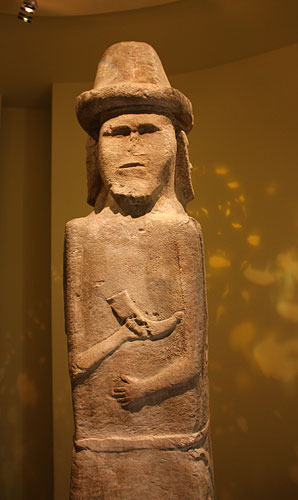
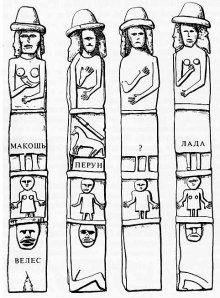
Figure Stribog - Rod - Svyatovit idol with tur’s (wild ox’s) horn “Horn of plenty” or “cornucopia”
D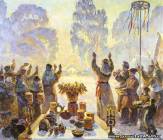 azhbog
– the Sun – the son of Svarog, the ancient god of Nature,
sunshine, "white light", benefits giver. Fully similar to
Apollo and opposed to the Christian God-the Son. Dazhbog and Stribog
both were heavenly gods.
azhbog
– the Sun – the son of Svarog, the ancient god of Nature,
sunshine, "white light", benefits giver. Fully similar to
Apollo and opposed to the Christian God-the Son. Dazhbog and Stribog
both were heavenly gods.
Figure Sacriface to Dazhbog
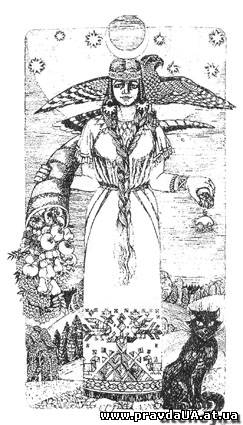
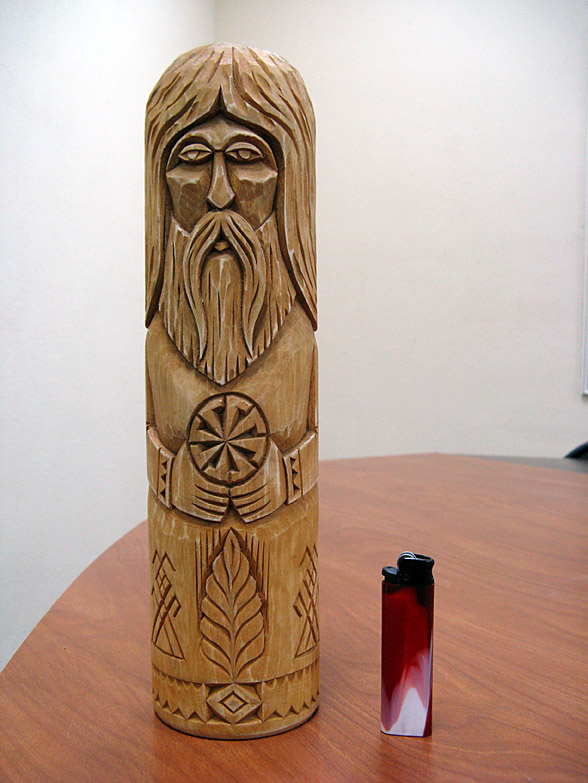
Figure Dazhbog idol Figure Makosh
Makosh. The ancient goddess of life-giving, the earth and fertility. Complement to it are "vily" – “rusalkas” – mermaids irrigating cornfields with dew. (Rusalka – in Slavic mythology, is a lake-dwelling soul of a child who died unbaptized or of a virgin who was drowned). Makosh can perhaps be equal to the Greek Demeter (“Earth-Mother”) and Christian Mother of God. It was often depicted with tur’s (wild ox’s) horn “Horn of plenty” or “cornucopia”.
S
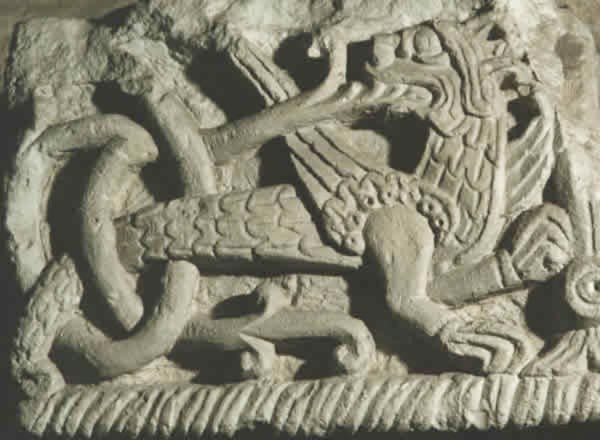 imargl.
Deity of seeds, shoots and plant roots. In a broader sense – a
symbol of “armed good.” It is a mediator between the supreme god
of heaven and the earth, his messenger. It is directly related to
Makosh, as a deity of vegetation, associated with the soil.
imargl.
Deity of seeds, shoots and plant roots. In a broader sense – a
symbol of “armed good.” It is a mediator between the supreme god
of heaven and the earth, his messenger. It is directly related to
Makosh, as a deity of vegetation, associated with the soil.
K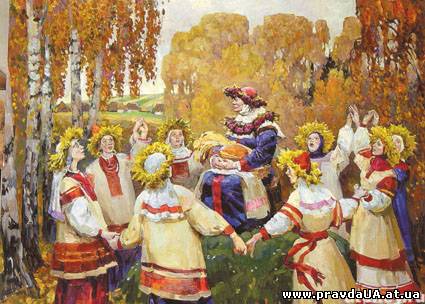 hors.
Deity of sunlight. It was an inseparable addition to the image of
Dazhbog the Sun. The name of Khors is associated with a ritual round
dance “khorovod” (means “to lead Khor”) and a Russian adverb
“khorosho” (means “well”), that is "Sunny." The
relations of Khors and Dazhbog analogical to Helios and Apollo
relations in Greek mythology.
hors.
Deity of sunlight. It was an inseparable addition to the image of
Dazhbog the Sun. The name of Khors is associated with a ritual round
dance “khorovod” (means “to lead Khor”) and a Russian adverb
“khorosho” (means “well”), that is "Sunny." The
relations of Khors and Dazhbog analogical to Helios and Apollo
relations in Greek mythology.
Figure Ritual round dance “khorovod”
As a result, there are three categories as if pagan gods: the first place is the nationally worshiped Perun, perceived not only as the god of Thunder, but also as a god weapons, warriors and Kings. The second category includes Stribog, Makosh and Dazhbog – the ancient gods of heaven, earth, and the “white light”. Additional deities fall into the third category: Khors supplements Dazhbog and Simargl – Makosh.
Question three. World view of the ancient Slavs.
Heathen Slavonic tribes believed that the world consisted of four parts: land, two of the heavens and an underground-water zone.
Many peoples depicted the earth as rounded plane, surrounded by water. Water was presented either as the sea, or in the form of two rivers surrounding the land. According to folklore, Slavonic understanding of the sea was unclear. The sea is somewhere on the other side of the earth. It can be in the north, where there is a glass-made Crystal Palace of Koshchei Immortal in the mountains, shining all colours of the rainbow. This is a reflection of the later knowledge of the Arctic Ocean and the northern lights. The sea can be normal, with no signs of the Arctic. Here, fishing and sailing are practiced, there is a girl's kingdom (Sarmatian) with cities built of stone; it is from here – the sea shores of the Dragon, the embodiment of nomads, started its raids on Holy Rus. This is a real historical sea – the Black Sea and the Sea of Azov, which has long been known to Slavs, and even at times bore the name of "the Russian sea". Folklore says that it is possible to ride to this sea quickly (just in three days, "skiroyu ezdoyu," as it was used to say in the XVI century) from the forest-steppe, the Slavonic ancestral home or from the southern outskirts of Slavic kingdoms (which is the same). Agricultural land was of great importance to the heathens: the land is the soil, bringing harvest, "Mother Crude/Wet land", that is the soil, saturated with moisture, feeding the plant roots, "Mother Earth", which is associated with a number of rituals and incantations. There is almost imperceptible border with the imaginary underground fairy world. Makosh, the goddess of fruit-bearing land, soil, "the mother of the harvest", was introduced in 980 AD to the pantheon of major Russian deities as the goddess of fertility.
The sky was viewed differently by farmers and hunters. While hunters seeked to know the stars and winds, that farmers were interested in the clouds and the sun.
Lack of knowledge about process the earth's water evaporation, clouds and fog ("dew") origin has formed a belief of permanent water supplies somewhere high above the earth, in heavens. This heavenly moisture can sometimes take the form of clouds and rain, and make the grass green and the crops yield. Hence, farmers believed in the Lord of heavenly water, controlling rain, showers and lightning. Alongside to the two archaic Mothers, the mighty Rod appeared – the Lord of heaven and the whole universe, the great life of giving, which blows life into all living things through the raindrops.
The sun was also worshiped by farmers, as source of light and heat, the spring of growth in total nature. The sun embodied stability. The entire annual cycle of pagan rituals was based on the four solar phases and subjected to 12 solar months. The Sun was a symbol of goodness, a sign of light overcoming the darkness in visual arts of all ages. Ancients Slavs, like many other nations have taken geocentric model of the world.
